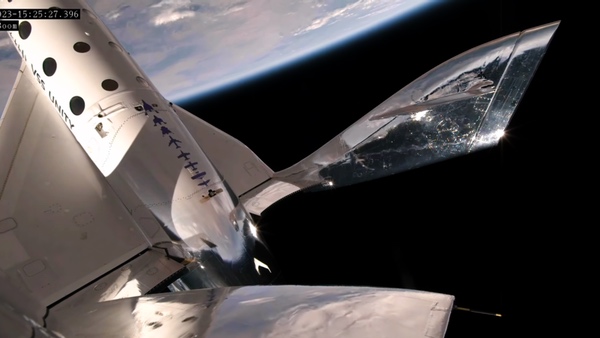Putting the private into private spaceflightby Jeff Foust
|
| What was different about Galactic 03, though, was the publicity surrounding it—or, rather, lack thereof. |
As with the two previous flights, Unity carried six people: two pilots, an astronaut trainer, and three customers. All three were among the first to sign up for Virgin Galactic flights, paying $200,000 for tickets as far back as 2004. The company has about 800 people who have purchased tickets and, in some cases, have been waiting more than 15 years for their opportunity to fly.
What was different about Galactic 03, though, was the publicity surrounding it—or, rather, lack thereof. Virgin Galactic did not provide a live webcast of the flight, instead providing play-by-play updates on social media. Moreover, it did not disclose the identity of the three customers—Ken Baxter, Timothy Nash, and Adrian Reynard—until after the mission was over and the company issued a press release confirming a successful flight.
That is a break in tradition in Western spaceflight, where crews of suborbital or orbital launches, by governments or companies, have been announced to the public before launch, days to months (sometimes years) in advance. Virgin Galactic did name the company personnel who would be on Galactic 03 in advance, but in an August 28 statement only mentioned that the customers “would become Virgin Galactic astronauts 014, 015 and 016.” The lack of information about those customers puzzled many people following the flight.
Some see this as a normalization of spaceflight. Airlines don’t publicly disclose who is on each of their flights, so it seems reasonable that spaceflight companies will follow the same practice as their flights become more common. Perhaps, there may come a time when Virgin or another provider does not disclose at all who was on a flight beyond a numeric designation.
Be we still have some ways to go before human spaceflight does become that routine. Virgin Galactic is still flying only once a month, a pace unlikely to change until its new Delta class of suborbital spaceplanes enters service around 2026, a schedule that assumes all goes well with the development and testing of those vehicles, which is hardly guaranteed.
That low rate of operations also means limited revenue for the company. Executives acknowledged in an earnings call in August that, with a monthly flight rate and only three customers on each flight, many of whom bought tickets at the original price of $200,000 years ago, there will be much revenue for the foreseeable future.
“When we look at the capacity of Unity and the ticket prices that we’re flying these days, you would expect to see for the near term about $600,000 per flight,” Michael Colglazier, CEO of Virgin Galactic, said in that earnings call. By next year, he said, the company expects to replace the astronaut trainer with a fourth customer, allowing the company to generate more revenue. Research flights like Galactic 01 will also produce more revenue—about $600,000 per seat, he estimated—but those will be far less frequent than tourist flights.
Virgin Galactic is still losing significant amounts of money given its limited revenue and high costs of developing the Delta-class vehicles: $134.4 million in the second quarter alone. It has been able to sell stock to raise money, giving it cash reserves of nearly $1 billion, but will likely need to continue that to be able to sell stock to complete development of the Delta vehicles and bridge the gap to operations.
| The industry is shifting, and that customers of private human spaceflight can and will have more control over how their journeys into space are publicized as flights eventually do become more routine. |
Another sign human spaceflight isn’t that routine yet is the status of Virgin Galactic’s competitor. The Galactic 03 flight took place almost exactly a year after Blue Origin’s latest New Shepard launch, which suffered an engine anomaly on an uncrewed flight carrying only research payloads. The capsule landed safely under parachutes, but the propulsion module was destroyed.
In March, the company announced it had completed the investigation into the mishap, concluding that the nozzle of the rocket engine suffered a structural failure linked to thermal damage. Blue Origin said then that flights would resume “soon” starting with another payload-only flight.
In early June, Bob Smith, CEO of Blue Origin, said at a Financial Times event that the company was “dotting the i’s and crossing the t’s” on plans to return New Shepard to flight and getting FAA approval to do so. “New Shepard, from that standpoint, should be ready to go fly within the next few weeks,” he said then. The vehicle has yet to return to flight.
It's clear, though, that the industry is shifting, and that customers of private human spaceflight can and will have more control over how their journeys into space are publicized as flights eventually do become more routine. That was the case even on Galactic 03: Baxter had a website where he documented his plans for the flight and even, before the flight, had a countdown to launch. (The Las Vegas real estate developer describes himself as “America’s First Space Tourist”—an appellation usually given to Dennis Tito, who went to the International Space Station in 2001—and “the first everyday American to visit outer space.” How “everyday American” is defined is unclear.)
Many others are like Baxter in the sense that they will want to broadcast their experiences, either through conventional or social media, for a range of motivations. Others, though, may see their journeys into suborbital space as more personal affairs to be shared with smaller audiences rather than webcast to the world. For them, the new era of private spaceflight will be as much about private as it is about spaceflight.
Note: we are using a new commenting system, which may require you to create a new account.
